In 2023, no technology has shaken the world quite like generative AI has, or ‘GenAI’, which unlike older forms of technology is creative or ‘generative’ across a wide range of media, and the emergence of GenAI in fact marks a major step forward in the erosion of the boundaries separating the human world from that of machines. Progress in this field has been astonishingly rapid, and public uptake of GenAI services has been equally swift and ChatGPT,1/ an intelligent chatbot developed by OpenAI,2/ clocked up more than 100 million users within just two months of becoming publicly available in November 2022,3/ the fastest adoption rate of any application in history.4/ Furthermore, GenAI-generated images have even won top prizes in global photography competitions.5/ With GenAI's capabilities, it has been hailed as a groundbreaking technology that is driving major transformations, not only for individuals but also for businesses, including the banking sector.
However, the combination of AI’s rapid emergence and its far-reaching capabilities has prompted widespread questioning of what the benefits of this technology will be, what impacts it will have on humanity, and what principles should guide its adoption. In light of the likely revolutionary consequences of the latter, it is imperative that all stakeholders, including the banking sector, carefully consider what repercussions GenAI adoption will have for them and how best to use these systems to their advantage.
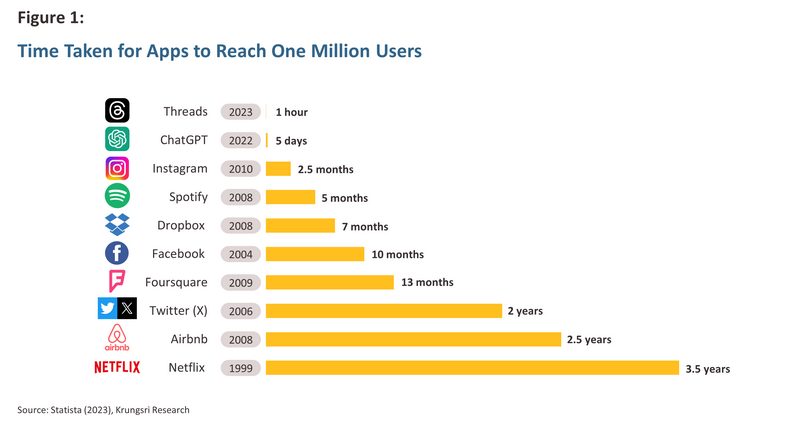


Understanding Generative AI
Generative AI, or Generative Artificial Intelligence, is a type of AI that is able to generate novel output not present in its training data, and this ability to ‘think’ creatively marks a significant break with earlier assumptions that creativity was a uniquely human trait. Moreover, GenAI is able to produce output in a range of forms, and in addition to responding in text to text-based queries and inputs, they can produce images, audio and video; they can design; they can produce computer code; and they can generate synthetic data.7/
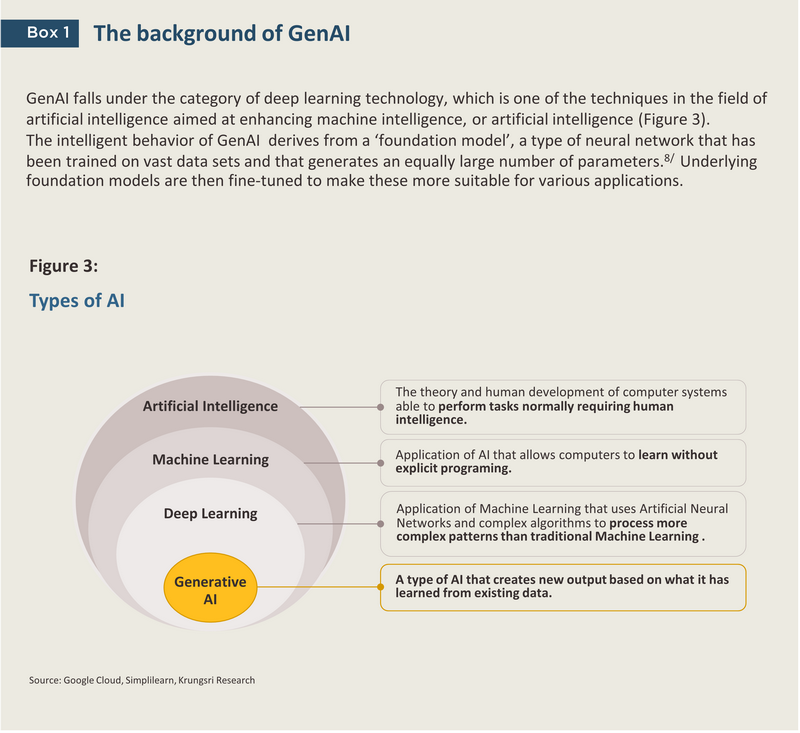
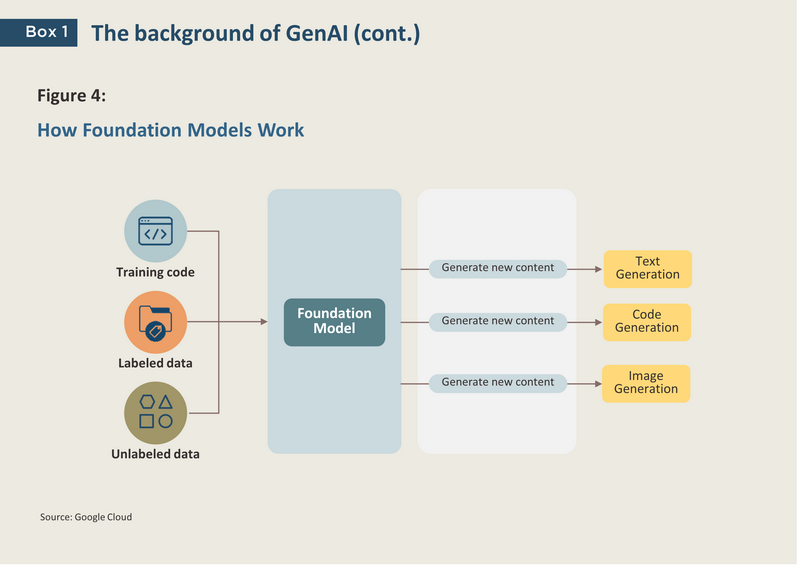
GenAI learns from training data that they are fed, analyzing the patterns, structures and characteristics of this to generate human-like output that, rather than being copied from any underlying data, is genuinely novel. Because of the way that GenAI works, the more data that is fed into the system, the more relationships it can identify and analyze, and this then helps the system produce higher quality, more creative responses. Moreover, basing on Large Language Models (LLMs)9/ allows users to interact with these without the need to write computer code (No-Code/Low-Code). Instead, GenAI has advanced Natural Language Processing (NLP) or human language capabilities that allow users to communicate with applications via ‘prompts’, i.e., written inputs or instructions composed in natural language. As a result of doing away with the need to write code, human-computer interactions are now very similar to regular human-to-human conversation.
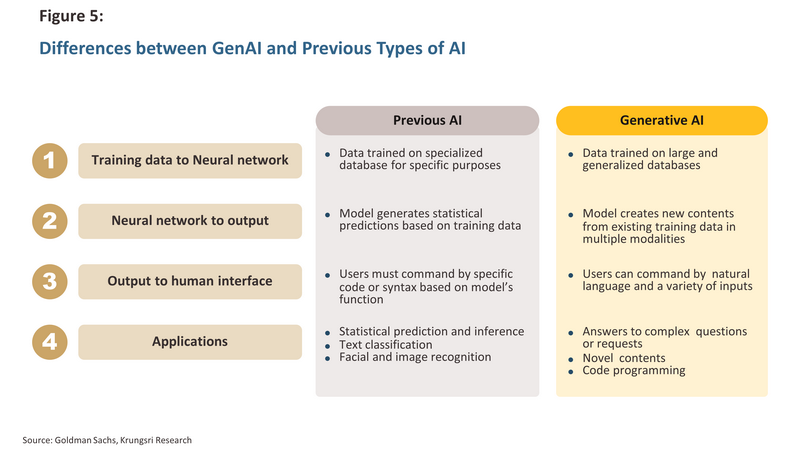
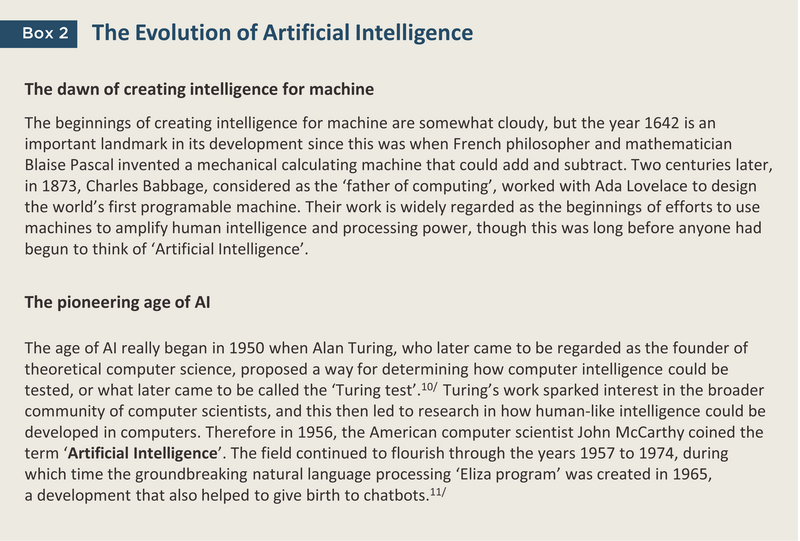
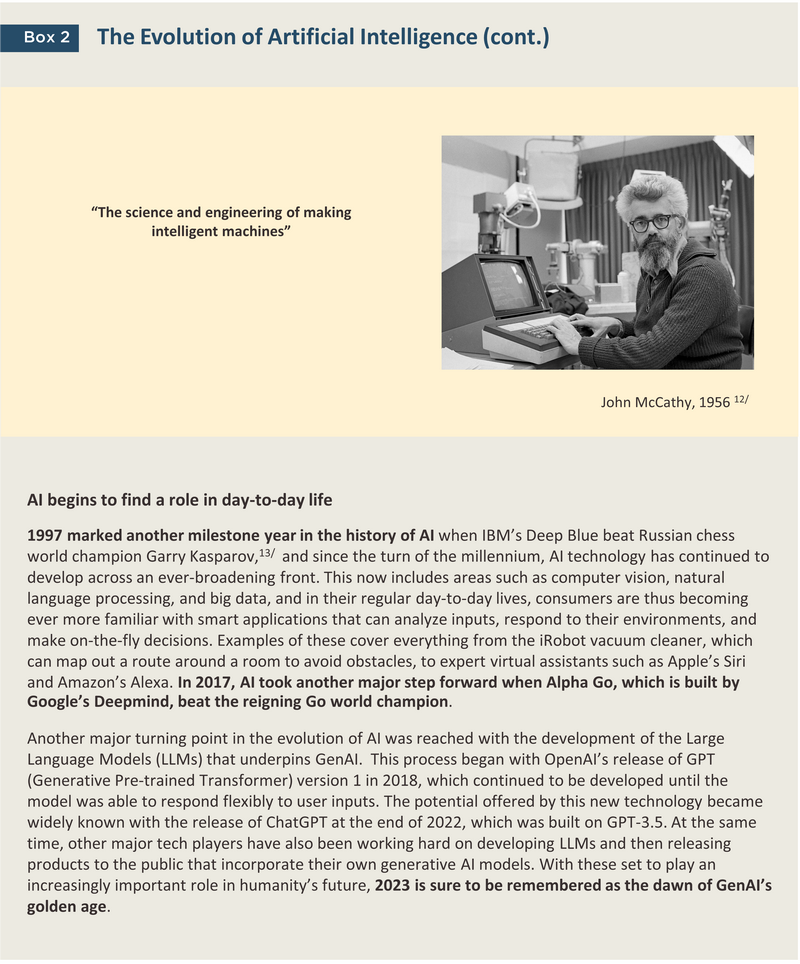
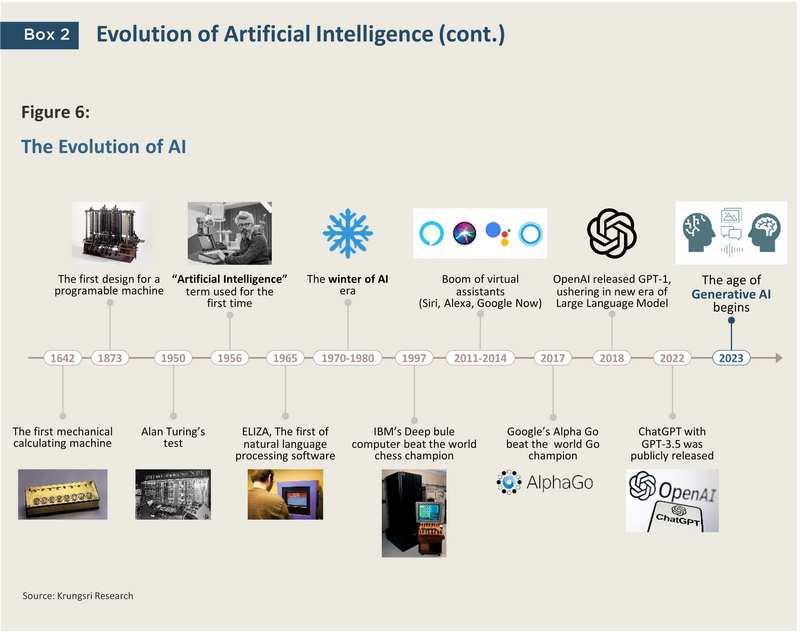
GenAI Captures Global Spotlight and Ignites Worldwide Interest
The brilliance of GenAI, and especially of ChatGPT, has put the world on alert that major changes are underway. Indeed, the release of ChatGPT can rightly be regarded as the point at which the world really began to understand the potential offered by AI and to start to look for ways to best exploit GenAI’s capabilities. A global survey of executives carried out by Gartner thus shows that 45% of respondents thought that the publicity around ChatGPT was a major impetus for beginning or increasing investment in GenAI.14/
The explosion of interest in GenAI has also had important consequences for the tech giants, which have now been pushed to significantly expand their AI investments. For example, Microsoft has sunk USD 13 billion in OpenAI to allow it to make the company’s ChatGPT technology available through Microsoft products.15/ Likewise, Google16/ and Meta17/ have also revealed their own GenAI projects as they look to compete in this new and rapidly evolving market. And it is not just American companies that are involved in this; in China, Baidu18/ and Alibaba19/ are each ploughing money into the development of GenAI as they look to fight for market space with other major players active in the same segment.
The global surge in interest in GenAI has brought with it a slew of papers pointing to the substantial future growth potential of this market. Allied Market Research shows that the value of the GenAI industry will surge more than ten-fold over a decade, jumping from just USD 8.2 billion in 2021 to USD 126.5 billion in 2031, thus giving compound annual growth of around 32% (Figure 7). Similarly, the value of investments made by venture capitalists in GenAI reached USD 4.5 billion in 2022, up more than an order of magnitude from 2018’s USD 400 million (Figure 8).
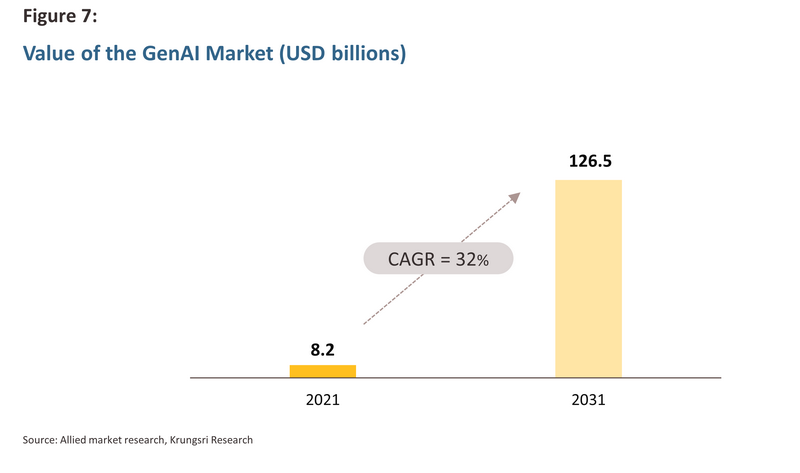
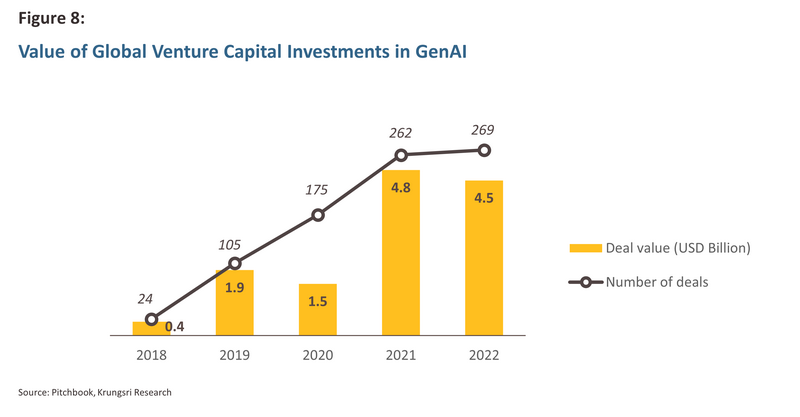
GenAI: A jack of all trades
GenAI’s standout features are its intelligence, its creativity, and its abilities in these areas are why AI will likely play a key role as an expert assistant improving employees’ efficiency and productivity. GenAI can therefore be expected to become a major driver of the global economy, a view supported by Goldman Sachs, which expects GenAI to boost GDP by an additional 7% (or by USD 7 trillions) and to lift productivity above the baseline case by 1.5% annually over the next decade.20/ At present, GenAI is beginning to find roles in the following areas:
1) Smart chatbots
One of the most obvious roles for GenAI is in powering smart chatbots that can respond instantly and accurately to requests or inquiries on almost any topic. In business contexts, GenAI can be used as the backend to customer service apps to help recommend appropriate goods and services, or within organizations, these products can be used to power chatbots on internal helpdesks.
2)
Creating content, and researching and designing products and services
GenAI is also creative, and generative AI programs are, as their name suggests, able to generate new ideas on a level that matches or beats human competition in areas as diverse as writing articles, captioning pictures, creating images, audio, and video, and developing Metaverse.21/ GenAI can therefore operate as a partner to human workers, sparking new ideas or creating content that is in keeping with its context, and its facility in these types of roles is reflected in Accenture’s assessment that by 2029, over 30% of all social media advertising could be automatically generated by AI.22/ GenAI is also expanding into areas such as more complicated design, where AI can help with designing and developing products while paying attention to principles derived from materials science. GenAI is even finding roles in matters of life and death, where GenAI is being used to research and develop new treatments for drugs.23/ It is becoming clearer that new GenAI are revolutionizing the creative industries in ways that are entirely novel, and those working in these parts of the economy may be justified in feeling growing disquiet over its apparently limitless abilities.
3) Developing software and writing coding
GenAI’s ability to understand natural language gives it the ability to then translate this into computer code, and this makes it much easier for users to write code and develop programs. GenAI’s abilities do not end with writing the software because these systems can also test for, identify, and assist with the elimination of bugs. Given this, it is perhaps not surprising that in a survey carried out by GitHub Copilot, 88% of respondents felt that using AI in their work as developers had made them more productive.24/
4)Analyzing, summarizing, and synthesizing information
In addition to the abilities described above, GenAI is also able to function as a kind of artificial brain that operates alongside humans, and its advanced analytic abilities allow human operatives to think more clearly and to improve their productivity. GenAI can thus be used to summarize the core points of text inputs, including even complicated legal documents. In a similar way, GenAI can bring these abilities to bear on business data, identifying key variables in inputs and using these to develop corporate strategy.
Beyond data analysis roles, GenAI can be used to generate synthetic data for use in modeling and testing in situations when it may be difficult or impossible to acquire real-world data, or in cases such as when limitations are imposed by the environment, e.g., for test data for consumer-facing use cases; and Gartner expects that by 2025, some 20% of this data will be synthetic.25/
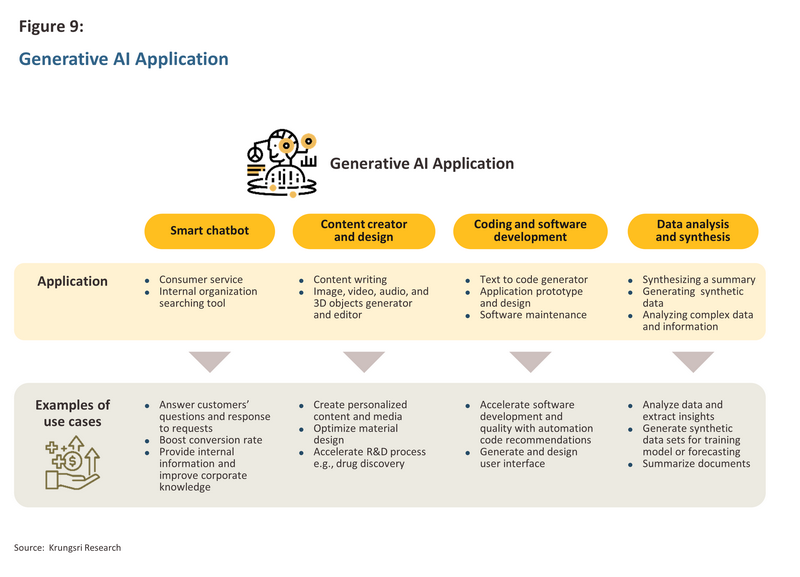

Given GenAI’s expertise across a wide range of areas, it is not surprising that since the start of 2023, a view has become very widespread that GenAI is a newly-emerged hero ready to swoop in and bring success to businesses across the economy. Indeed, a global survey of executives by Accenture revealed that 98% of respondents agreed that AI will have an important role to play in determining organizational strategy over the next 3-5 years.27/ Likewise, a survey by Gartner showed that when investing in GenAI, businesses’ most important goals are first to improve the customer experience and then to increase income (Figure 10).28/
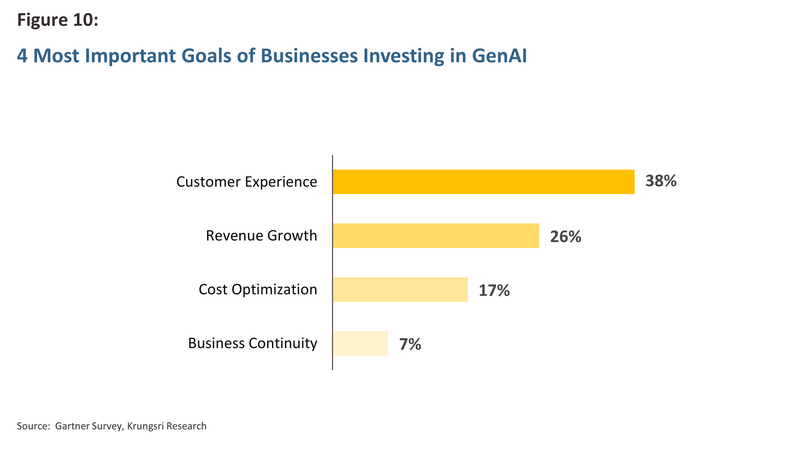
GenAI’s abilities threaten individuals working in almost all positions
In the past, the negative impacts of technological progress, in particular of mechanization and automation, were largely felt by unskilled labor, which was displaced by machines that increased productivity, reduced production time, and were more reliable and accurate when completing repetitive operations. In parts of the economy, this process has resulted in blue-collar workers being almost entirely replaced by automated processes, but the latest wave of technological change is having very different effects, and GenAI is posing a much greater danger to white-collar workers, in particular to those in: (i) customer-facing roles, such as those working in customer service; (ii) creative roles, such as writing, illustration, and design; and (iii) highly-skilled roles, such as engineers, programmers, and analysts. And whereas in the past, workers in these roles had been broadly insulated from the impacts of technological innovation, GenAI has now opened even these parts of the economy to the winds of change.
An indication of the scale of the changes that may lie ahead can be seen in research by Goldman Sachs that indicates that GenAI has the potential to replace over 300 million positions globally, or a quarter of all jobs in the US and Europe,29/ and indeed signs of these changes are already becoming evident. For example, the UK telecoms company BT Group recently announced that thanks to recent advances in technology, and especially in the development of AI capabilities, it would now lay off over 10,000 employees.30/
Using GenAI in the banking sector
Prior work by Krungsri Research analyzing various technologies in terms of their time to and size of impact has shown that from 2023, AI would be among the most consequential technologies for the banking industry.31/ AI is also a core part of the digital first strategy on both the operational and customer service sides of the business, and the advent of GenAI has only underscored its centrality.
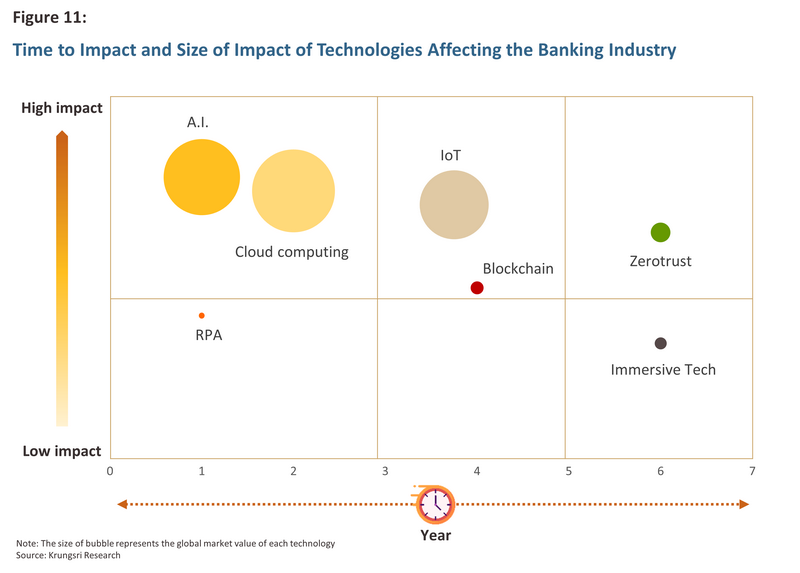
Accenture shows that GenAI has the potential to make extremely significant inroads into the banking sector, and 54% of working hours in the industry may be susceptible to being fully automated by AI, the highest proportion of any part of the economy.32/ Boston Consulting Group also estimates that within the overall market for GenAI, by 2027, the value of the banking and financial services sector will come to USD 32 billion, up from a start of just USD 2 billion in 2022. This thus represents an astonishing compound annual growth rate of 74%, and overall, the segment will account for over a fifth of the total market value33/ (Figure 13). The sudden emergence of GenAI is therefore pushing banks to step up their investments in technology as they look to maximize the benefits that can be wrung from this.
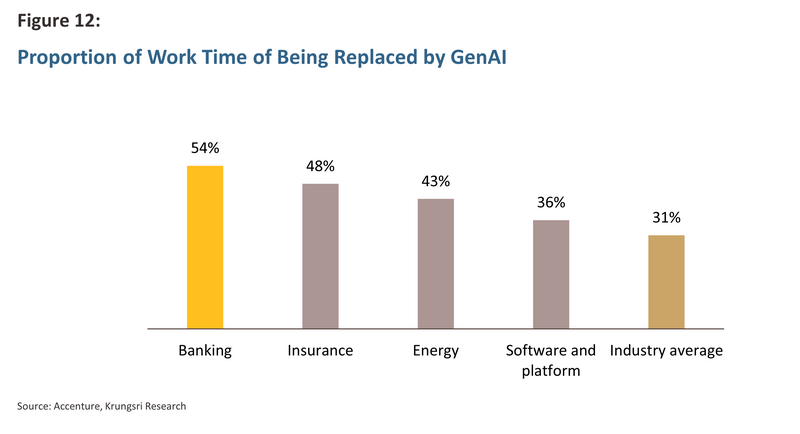
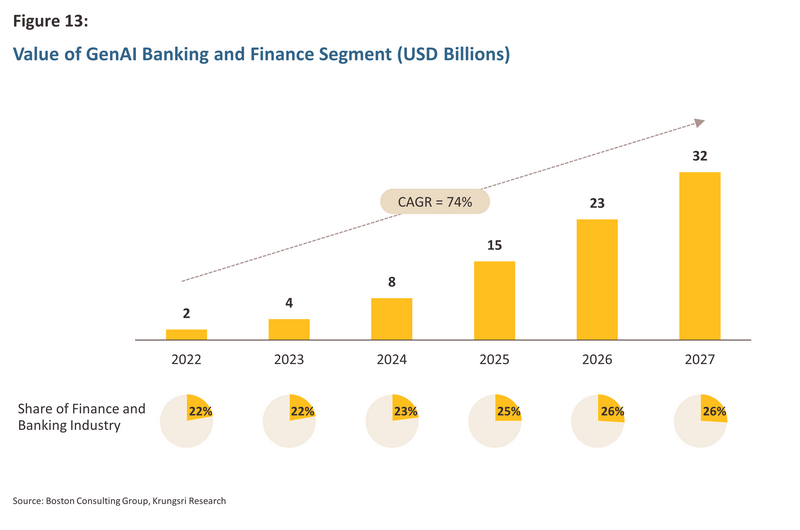
With GenAI an increasingly central player in the operations of almost all organizations, it is clearly crucial for banks to understand how this technology can be leveraged to provide the maximum benefit, and McKinsey estimates that fully exploiting GenAI’s potential will add USD 340 billion to annual income for the banking industry globally.34/ This would involve using GenAI in the following ways:
Front-office functions
- Customer services Banks will be able to use GenAI to power chatbots, and these could then function as virtual assistants improving the user experience. AI chatbots can assist with a range of customer service tasks, helping customers complete financial transactions, offering personalized products and services, educating users on financial knowledges, and carrying out initial credit assessments. In addition to making the customer journey smoother and more responsive to individual needs, research also indicates that providing customer service through chatbots will help the banking industry save USD 7.3 billion globally by 2023.35/ Moreover, using GenAI in customer support roles can also increase productivity by up to 14%.36/
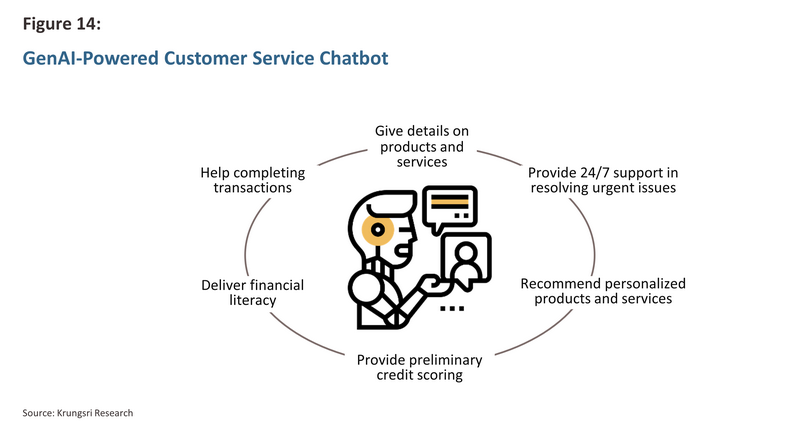
- Sale and Marketing GenAI has the potential to boost the productivity of banks’ sales and marketing efforts by: (i) improving customer analytics, which will then feed through into more effective and better targeted marketing campaigns and promotions, and allow for improved prediction of consumer behavior, which in turn will help banks design products and services that more directly meet customer needs; (ii) assisting with the production of personalized marketing content, thus improving customer engagement rates; and (iii) powering chatbots that work alongside staff and financial advisors to provide information on the bank’s products and services and to instantly recommend investments that are a good match for individual consumer needs.
Using GenAI in front-office applications will help banks improve customer relations37/ and provide a means for more effectively introducing consumers to new products, thereby adding to income while cutting costs related to customer services. McKinsey estimates that if banks can effectively rollout personalized banking services, this should increase income by some 15%,38/ while Salesforce sees GenAI being a game changer for marketing departments, potentially saving as much as 5 hours in an average working week.39/
Middle-office functions
- Credit analysis In the past, credit assessments were based on an individual’s history of debt repayments coupled with an evaluation of their current income. However, introducing GenAI to the process allows for much more efficient processing of credit applications since the scope of the data on which credit decisions are made can be expanded to include information embedded in contracts and other types of loan documents, as well as other types of data altogether such as ‘alternative data’ from utility bill payments. By taking advantage of GenAI’s abilities to assess a borrower’s potential, banks will be able to make quicker, more accurate assessments of an individual’s credit risk, especially when these systems are coupled with other analytical tools and are subject to human oversight.
In addition to improving the efficiency of credit assessments, and thus cutting the risk associated with the issuing of new credit, GenAI is also able to almost-instantaneously assess the proposed credit limit or loan size and to suggest the most appropriate form of credit for a particular customer, and the speed and accuracy of these services will then help front-office operations offer a much more satisfactory customer experience.
Back-office functions
- Fraud detection In addition to making customers’ lives more convenient, the relentless advance of technology also creates a steady stream of new opportunities for criminals and scammers, who are able to use new technology to make more intelligent and more sophisticated tools with which to defraud both banks and their customers. Banks must thus remain responsive to this constantly changing landscape, and banking cybersecurity operations have to be at the top of their game. However, by acting as a bank’s watchdog, this will be another area where GenAI is able to help. In particular, GenAI is able to very efficiently oversee transactions and then to raise alerts when it encounters any that appear to be potentially fraudulent. By using a technology known as generative adversarial networks (GANs),40/ GenAI is also able to generate synthetic data and then to use this to train systems that are hunting for suspicious activity, and research shows that this has a 98% hit rate when looking for fraudulent activity occurring.41/
- Compliance Regulation of the banking and financial sector is particularly tight, and in 2022, abiding by compliance and anti-money laundering regulations carried a global price tag of USD 274 billion,42/ but this is another area where generative AI may find a role helping banks to cut overheads and reduce errors. Notably, GenAI could help with compliance by: (i) assisting with the drafting and checking of banking documents and contracts, ensuring that these are not in breach of the regulatory requirements; and (ii) educating staff or responding to staff queries on compliance when questions about this arise.
- Risk management GenAI may be used to help with analysis and decision making when planning measures to mitigate a bank’s exposure to risk. GenAI’s involvement in these processes will be multifaceted, covering areas as broad as data collection and analysis, summarizing the findings of this analysis and the variables affecting risk exposure, assessing likely future trends, using GANs to estimate Value-at-Risk (VaR), simulating economic or financial market scenarios to see how these will impact the bank, and writing and testing computer code used to construct risk forecasting models.
- Efficiency improvement Many departments within banks will be able to use GenAI to improve their efficiency and productivity. For example, human resource (HR) departments can use GenAI to help screen resumes or CVs from job applicants, or AI could assist in interviews by suggesting lines of questioning that are appropriate for a particular position. On the other hand, in IT departments, GenAI could be used to help write code used in software development, or to assist with the maintenance of enterprise software and hardware.
It is clear that GenAI can be deployed at almost every point of the banking value chain, from improving the customer experience to raising operating efficiencies and cutting overheads. Nevertheless, this broad range of possibilities may only be scratching the surface of the ways in which GenAI may disrupt the banking industry, and the potential of this technology will only continue to expand. It is therefore essential that these developments are monitored closely and as progress is made, these innovations are used to further raise banks’ productivity and potential.
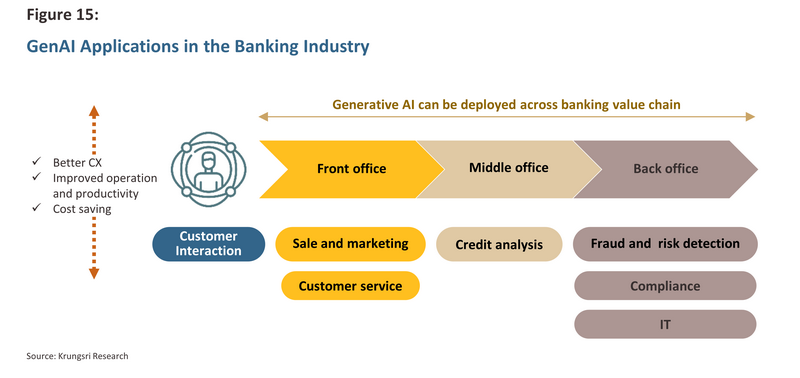
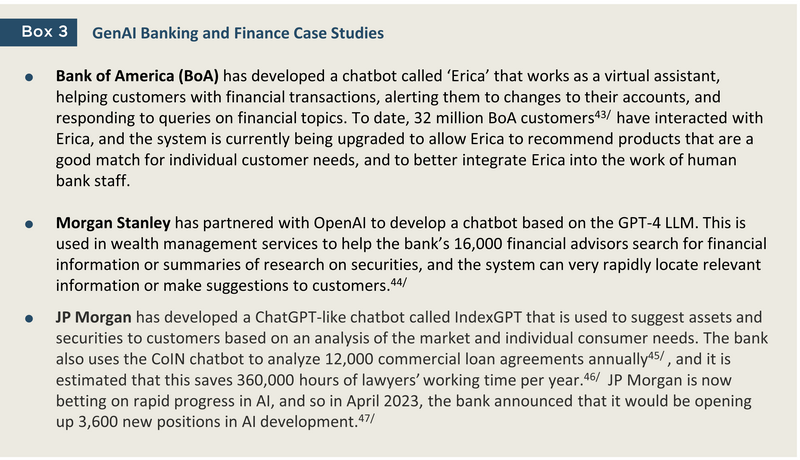
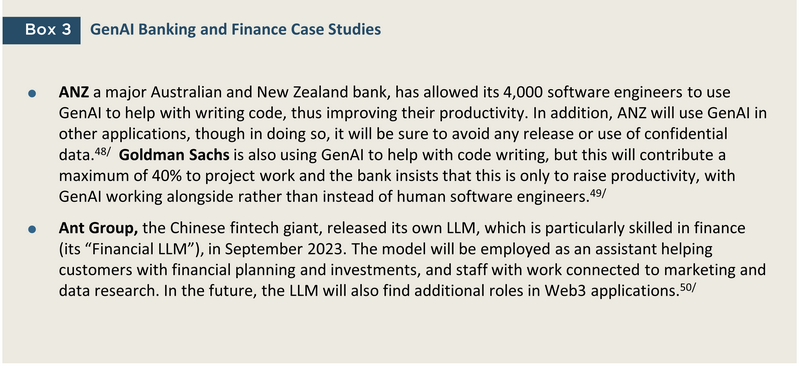
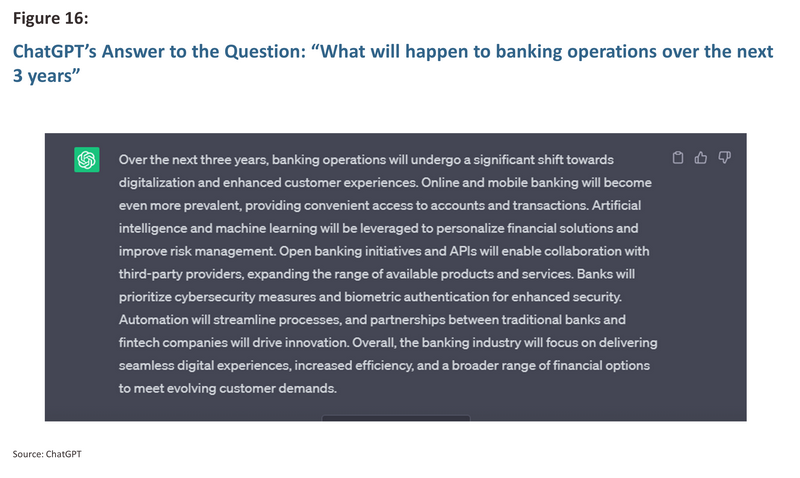
Expertise coupled with risk
Technology always has the potential to be a double-edged sword, and before adopting any innovative new tech, costs and benefits must be carefully balanced. This is especially so in the banking sector, where trust and data security are at the core of business operations. Given this, incorporating GenAI into business processes should only be considered once an extremely careful and comprehensive assessment has been made of the risks inherent in this.
The accuracy of responses
Users of GenAI will need to exercise their judgement when accessing these systems, and AI-generated responses should never be accepted at face value. This is because, as has been well demonstrated, GenAI systems are prone to what are called ‘hallucinations’ , that is, answers to queries may look superficially believable while being entirely false. This happens because while it may seem as if the system is responding to a prompt by consulting an enormous internal database, it is actually just producing output based on which words are most likely to appear in a given context, as determined by the dataset on which it was trained.51/ Moreover, because the latter determines a GenAI model’s output, the date when the training data ceased being updated will mark the limits of the model’s ‘knowledge’. For example, ChatGPT is based on the GPT-3.5 LLM, and the training data for this only goes up to 202152/ meaning that without additional help, the system has no access to information more recent than this. Worryingly, GenAI is also increasingly being used by those wishing to mislead, misinform or otherwise deceive the public, and so AI systems are becoming a major source of fake news and harmful content.
Given the uncertainties around the veracity of some GenAI responses, these should never be considered as any more than suggestions or first drafts, and where it involves any factual statements being made or implied about the world, GenAI-generated output should always be subject to informed human judgement.

The risk of leaks of sensitive data
Because continuing advances in GenAI capabilities rely on these systems being fed with a constant stream of inputs to analyze, there is a risk that any sensitive or secret data that is included in inputs may be leaked in output later generated by the AI. Major US banks including JP Morgan, Bank of America, Citi, Goldman Sachs, and Wells Fargo have responded to these problems by banning their employees from using ChatGPT,53/ and worries over the potential for sensitive data to be released have also prompted three Japanese banking giants (Mitsubishi UFJ Financial Group (MUFG), Sumitomo Mitsui Financial Group (SMFG) and Mizuho Financial Group) to partner with Microsoft to develop their own chatbot for internal use only.54/
Fears rise globally over AI’s capabilities
The explosion in AI’s abilities has raised fears over the potential for this technology to be misused, and in March 2023, many well-known individuals in the tech field including Elon Musk (founder of Tesla) and Steve Wozniak (one of Apple’s founders) joined with the Future of Life Institute to co-sign a letter calling for a 6-month moratorium on the development of AI with abilities beyond those of the GPT-4 LLM, with the intention that this time would allow for a better assessment of AI’s pros and cons and the potential dangers inherent in this field.55/ Likewise, Geoffrey Hinton, the ‘Godfather of AI’, has expressed alarm at how fast progress is being made, and Hinton believes that intense competition between tech giants to bring AI models to market as fast as possible is making oversight difficult and will potentially lead to an explosion in uses related to cybercrime and the dissemination of fake news.56/
The unexpectedly fast development of AI capabilities has meant that legal and regulatory oversight is largely absent from the field, and the surge in worries over this led to discussions on AI at the May 2023 meeting of the G7, the group of seven leading industrialized economies.57/ Recognition of the need for serious global regulation is such that at the meeting, ‘The Hiroshima Process’ was agreed, and plans have been made for ministerial-level discussions to take place at the end of 2023 This reflects the growing recognition that global regulation and oversight of AI have become crucial matters.
Will AI become smarter than humans and dominate the world?
The type of AI that has recently taken the world by storm is categorized as ‘Artificial Narrow Intelligence’ (ANI). This type of AI is created to achieve a particular task or goal, and to do this, it needs to receive instructions from a human operator. However, the next stage of AI development will broaden these abilities, with Auto-GPT or Agent-AI58/ acting in quasi-managerial roles thinking and acting on behalf of humans. These agents can create their own strategies for achieving specified ends, and then to activate other AI systems as they put these strategies into play. Developments such as this will then allow AI to operate autonomously, side-stepping the need to have humans provide step-by-step instructions.
While the capabilities of AI agents are striking, these pale beside the possibilities offered by Artificial General Intelligence (AGI). AGI, if it were achieved, would be an extremely advanced type of AI that could consider, analyze and solve problems in human-like ways, and AI experts have thus dubbed this ‘Godlike AI’.
At present, it is impossible to say when, or even if, researchers will be able to produce AGI, but many are beginning to suspect that AI might be able to achieve human or post-human abilities across all domains, or what might be called Artificial Super Intelligence (ASI), and in light of the potential dangers inherent in these developments, executives at OpenAI have called for greater management and oversight of ASI. A survey of 738 AI researchers also shows that around half believe that there is at least a 10% chance that future progress in AI could result in extremely negative outcomes for humanity, including its complete extinction.59/
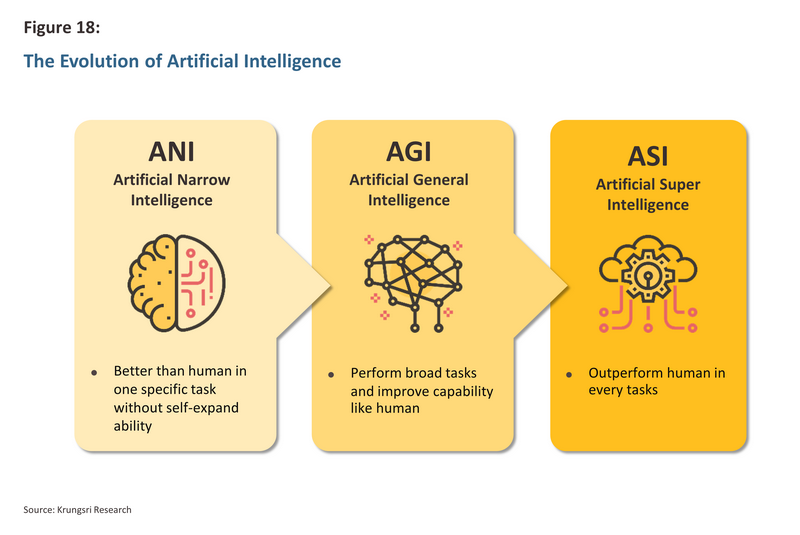
Guidelines for the use of GenAI in the banking industry
Beyond exploiting the many possibilities offered by GenAI, commercial banks will need to carefully consider the numerous negative impacts that this technology may have for businesses operating in the financial sector. These include those arising from the use of GenAI itself, as well as from the additional abilities that GenAI will give scammers and cybercriminals, such as being able to impersonate an individual’s appearance or voice, or to get around Know Your Customer (KYC) regulations. Faced with this and the need to maximize the benefits and minimize the costs associated with the use of GenAI, banks will need to both accelerate their work in this area and raise their defenses, and this will likely involve the following:
- Planning for how to develop employees’ ability to work with AI
At present, AI cannot fully replace the work of human employees, but the technology is extremely powerful, and this allows it to work as a very capable assistant that can significantly raise AI operators’ productivity. The World Economic Forum thus sees AI and machine learning being the fastest growing job roles over 2023-2027, with bank tellers being the fastest contracting.60/ A survey by Nvidia of finance industry executives also reveals that 43% plan to increase hiring of AI experts,61/ and this suggests that in the near future, it might well be the case that workers not using AI will be replaced by those who do. In light of this, developing employees’ AI skills (including how to work with AI and how to use AI responsibly) will form an important part of banking strategy.
In addition to developing the ability of employees to work with AI, banks will also need to improve their working environment if they wish to attract and retain staff skilled in the use and development of AI. This will also include putting in place training programs to ensure that staff develop the skills that GenAI is as yet unable to replicate, such as employees’ holistic and strategic thinking, and their emotional intelligence, factors that are extremely important in customer service and in improving communication and team-working skills. Staff will also need to be trained in how to use AI to assist with planning and problem solving.62/
- Checking for regulatory compliance
As stated above, a major risk with GenAI is the regularity with which inaccurate or outright false information is included in responses. This is particularly a problem in contexts involving banks since to a large extent, these trade on their honesty and probity. Worse, the problems inherent in how GenAI are being amplified by the prevailing business environment, and the fierce competition means that organizations are rushing GenAI products to market before they are fully ready, with the result that the quality and reliability of outputs is suffering. A very clear example of this was seen in Google’s hurried release of its chatbot or Bard, and despite its status as a tech giant with access to enormous resources, the company failed to ensure that Bard was ready for its public debut. Indeed, during its first public demonstration, Bard made a factual error, in the process wiping USD 100 million from Alphabet’s market value (Google’s owner).63/
With these risks so prevalent and because, as stated above, ‘trustworthiness and integrity’ are core banking values, when banks do develop and deploy their own GenAI systems, it is imperative that a full risk assessment is caried out. In addition, before any AI systems go live, they will have to be tested as comprehensively as possible, and this will need to include ensuring that their use is not in contravention of the relevant rules and regulations. Even then, it will be equally important that staff are drilled in not taking GenAI output at face value and that it becomes second nature to use a maximum of care and judgement when dealing with anything produced by these systems. This is because any failures in this area could have extremely widespread consequences, leading to potentially enormous losses. Moreover, if a GenAI is connected with or consumes sensitive customer or business data, the bank will need to be certain that there is no possibility of this information being leaked and that all operations are in line with the provisions of the Personal Data Protection Act.
- Tracking changes to the regulatory environment, especially of laws targeting AI
Authorities in many countries are now looking at how best to develop regulatory frameworks to control the development and application of AI systems, and to manage any risks arising from their use. Among the most advanced of these efforts is the EU’s Artificial Intelligence Act, which aims to prevent inappropriate uses of this technology and to head off the various risks associated with it.64/ In China, the authorities have also introduced laws governing the provision of GenAI services to the public, and from August 2023, service providers will need to pass tests that check data security and ensure that generated content is in keeping with China’s ‘core socialist values’.65/ In fact, some countries have gone so far as to ‘ban’ ChatGPT completely. These include Russia, China, and Italy, which following worries over the veracity of ChatGPT’s outputs, its lack of transparency, and the risk of data leaks, became the first western country to institute such a prohibition.66/
In conclusion, if banks successfully seize and exploit the multiple possibilities offered by GenAI, they will have the opportunity to create enormous additional value, but at the same time, introducing GenAI to business processes will bring with it substantial risks. This will therefore need to be carried out very carefully, and if banks are negligent in this, the resulting damages could be stupendous. To reduce the risks associated with the use of GenAI, banks will need to be absolutely certain that staff always treat GenAI outputs with extreme care and that they are meticulous in checking the veracity of any claims this output contain before making further use of this material. Banks will also need to ensure that sensitive data is not used in inputs to open systems, and before GenAI are used either internally or to help in customer facing roles, banks will have to carry out extremely extensive testing. In addition, banks will need to be proactive in adopting regulations that are in line with changing GenAI capabilities.
Krungsri Research view: Banks to be careful about how they approach GenAI deployment
With traditional banks and new entrants to the market, in particular fintech players, competing intensely to provide financial services, technological advances have presented banks with the opportunity to use their huge stores of data to develop GenAI models and so increase their operating efficiencies and improve their customer services.67/ However, this will need to be based on a careful assessment of the various use-cases of the system, the state of the available datasets, the level of in-house skills, and the budgets that are available. Moreover, Gartner estimates that as of 2022, widespread data and algorithm bias means that 85% of AI projects could potentially deliver misleading or erroneous results,68/ but if banks are able to sidestep these problems and move forward with a GenAI strategy that is in line with their abilities and requirements, this will help to ensure that the goal of adopting this technology remains clear, its possibilities are maximized, solid returns on investment are maintained, and that the bank remains competitive in an increasingly crowded market.
Boston Consulting Group69/ suggests two approaches for developing and applying GenAI (Figure 19):
The first approach: Fine tuning model This approach involves using a GenAI model created by another company but fine tuning this to make it as suitable as possible for the context of an individual bank. The model could be accessed through an API,70/ hosted on a cloud-based platform, or operated as an on-premise service. The advantage of this approach is that it saves time and money, but its disadvantage is that the bank would not have access to the foundation model, and so it would not be able to make immediate alterations at that level. The bank may also face limitations in terms of the flexibility of the resulting system and its ability to be used in specialist banking applications.
The second approach: Training model This approach involves the bank training its own GenAI model. In this case, the bank might partner with a company that has developed a foundation model to provide it with the abilities to research and develop a model adapted to its particular needs, or the bank might undertake the entire process itself. Clearly, this requires that the bank has access not just to suitably qualified and experienced staff but also sufficiently high-quality training data. The advantage of this approach is that it allows the bank to develop a GenAI model that matches its requirements very closely, but its disadvantage is that this will also carry higher overheads, and the bank will need to ensure that in-house know-how is adequate to the task.
In light of Boston Consulting Group’s suggestions, Krungsri Research believes that it would be best to first develop a banking GenAI application for use in internal procedures, but once this has been fully developed and tested, it could then be introduced into roles interacting with customers. Initially, a bank might begin its voyage into the world of GenAI by fine tuning a foundation model developed by a third party, but if in the future the bank has access to the required training data, expertise, and financial resources, it would then be possible to develop its own foundation model. This would allow the bank to overcome the limitations inherent in relying on a third-party provider, as well as helping it to develop more niche banking services and bring innovations to market ahead of its competitors.
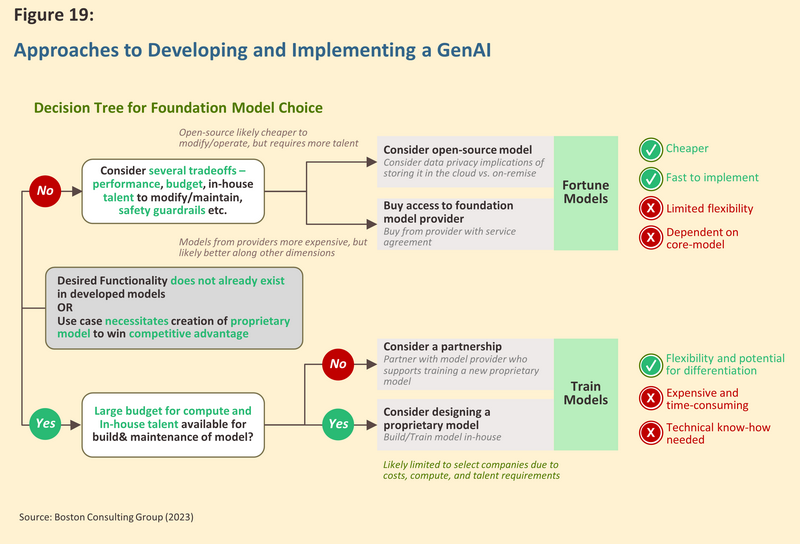
Ultimately, as knowledge and acceptance of the many benefits and advantages – but equally many dangers and problems – that AI will bring to humanity are acknowledged, banks will have no choice but to closely and unceasingly monitor how technological progress moves forward and how the domestic and international regulatory architecture evolves.
References
Aaron Mok (2023) “What is AGI? How Artificial General Intelligence could make humans obsolete”. Retrieved June 10, 2023 from https://www.businessinsider.com/what-is-agi-artificial-general-intelligence-explained-2023-5
Accenture (2023) “A new era of generative AI for everyone”. Retrieved April 27, 2023 from https://www.accenture.com/content/dam/accenture/final/accenture-com/document/Accenture-A-New-Era-of-Generative-AI-for-Everyone.pdf
Accenture (2023) “Technology Vision 2023 When Atoms meet Bits The foundations of our new realit”. Retrieved April 27, 2023 from https://www.accenture.com/content/dam/accenture/final/accenture-com/a-com-custom-component/iconic/document/Accenture-Technology-Vision-2023-Full-Report.pdf
Angela Strange Et al. (2023) “Financial Services Will Embrace Generative AI Faster Than You Think”. Retrieved May 24, 2023 from https://a16z.com/financial-services-will-embrace-generative-ai-faster-than-you-think/
Aruna Pattam (May, 2023) “Generative AI Applications: Episode #1: In Banking”. Retrieved May 25, 2023 from https://www.linkedin.com/pulse/generative-ai-applications-episode-1-banking-aruna-pattam/
Deloitte AI Institute (March, 2023) “Generative AI is all the rage”. Retrieved May 13, 2023 from https://www2.deloitte.com/content/dam/Deloitte/us/Documents/deloitte-analytics/us-ai-institute-gen-ai-for-enterprises.pdf?fbclid=IwAR0nhPJEhfHv3ZJKVy75PzzZuk94ui_Km1v0Q0oatuI7knhbARLoZ2euNvY
Express Computer (May, 2023) “How Generative AI is Driving Change in Financial Services”. Retrieved May 30, 2023 from https://www.expresscomputer.in/artificial-intelligence-ai/how-generative-ai-is-driving-change-in-financial-services/97357/
François Candelo Et al. (March, 2023) “The CEO’s Guide to the Generative AI Revolution”. Retrieved May 7, 2023 from https://mkt-bcg-com-public-pdfs.s3.amazonaws.com/prod/ceo-guide-to-ai-revolution.pdf
Jackie Wiles (January, 2023) “Beyond ChatGPT: The Future of Generative AI for Enterprises”. Retrieved April 27, 2023 from https://www.gartner.com/en/articles/beyond-chatgpt-the-future-of-generative-ai-for-enterprises
Jenna McNamee (March, 2023) “Generative AI has the power to transform the banking industry over the next three years”. Retrieved April 27, 2023 from https://www.insiderintelligence.com/content/generative-ai-transform-banking
KPMG International (April, 2023) “Generative AI models — the risks and potential rewards in business”. Retrieved May 23, 2023 from https://assets.kpmg.com/content/dam/kpmg/xx/pdf/2023/04/generative-ai-models-the-risks-and-potential-rewards-in-business.pdf?fbclid=IwAR12MwuUcuxTunfd2VFwtA8boQAa5oNyWeZEYSGilcv6EBAcyIZquxIzfMI
L.E.K (2023) “Generative Artificial Intelligence (AI): Who (or What) Wrote This?”. Retrieved May 26, 2023 from https://www.lek.com/sites/default/files/PDFs/healthcare-generative-ai.pdf?fbclid=IwAR3uWsqJQFZ3p8Js2Z0DzSgprKlGVKPMx9BbtSZQtTp_xy3-Y_eIE2HppbA
MarketingOpps! (April, 2023) “รู้จัก Auto-GPT อีกขั้นของปัญญาประดิษฐ์ที่เหนือกว่า ChatGPT อีกก้าวของ AI ที่พัฒนาเข้าใกล้มนุษย์อีกระดับ”. Retrieved June14, 2023 from https://www.marketingoops.com/tech-2/auto-gpt-ai-agi/
Michael Chui Et al. (December, 2022) “Generative AI is here: How tools like ChatGPT could change your business”. Retrieved April 27, 2023 from https://www.mckinsey.com/capabilities/quantumblack/our-insights/generative-ai-is-here-how-tools-like-chatgpt-could-change-your-business
Owen Hughes (August, 2023) “Generative AI Defined: How it Works, Benefits and Dangers”. Retrieved August 17, 2023 from https://www.techrepublic.com/article/what-is-generative-ai/?fbclid=IwAR1SJX_93Ow6aArEh68m61x1g8ZNfRzdZQ7Khl0ovKlIW9_uNVX2n0fHPT0
Post today (January, 2023) “สุดยอดเทรนด์เทคโนโลยี 2023 คาดเปลี่ยนโฉมอุตสาหกรรมในอนาคต”. Retrieved May 17, 2023 from https://www.posttoday.com/international-news/689466
Ravin Jesuthasan (April, 2023) “Here's how companies should navigate generative AI in the world of work”. June 14, 2023 from https://www.weforum.org/agenda/2023/04/how-companies-should-navigate-generative-ai-in-future-of-work/?fbclid=IwAR1N3ErERnT4VcYjRKIs3ofmh72NHF8k1pG4D8Q2Pt7rzArecvjfOiVPo3A
Techsauce (January, 2023) “Generative AI คืออะไร ทำไมถึงโดดเด่นกว่า AI ทั่วไป มุมมองความเป็นไปได้ในอนาคต”. Retrieved May 17, 2023 from https://techsauce.co/saucy-thoughts/what-is-generative-ai-and-how-it-changing-possibility
The Fintech Times (April, 2023) “Why Generative AI is Banking’s Solution to Big Tech Challenge”. Retrieved May 25, 2023 from https://thefintechtimes.com/why-generative-ai-is-bankings-solution-to-big-tech-challenge/
1/ ChatGPT was developed by OpenAI, who released the product to the public in November 2022. This is a ‘Large Language Model’ (LLM) built using deep learning technology, and this enables it to generate human-like responses to natural language inputs. The underlying model is called GPT (Generative Pre-trained Transformer) 3.5, though in March 2023, OpenAI released GPT-4, a multimodal LLM that can operate on both text and visual inputs and outputs. GPT-4 also performs better than GPT-3.5 on both understanding inputs and creating outputs.
2/ OpenAI was founded in 2015 as a startup devoted to AI research and development, with the stated goal of using AI to benefit humanity. (https://openai.com/about)
3/ https://www.reuters.com/technology/chatgpt-sets-record-fastest-growing-user-base-analyst-note-2023-02-01/#:~:text=Feb%201%20(Reuters)%20%2D%20ChatGPT,a%20UBS%20study%20on%20Wednesday.
4/ This does not include Threads, Meta’s microblogging social media site that was intended as a challenger to Twitter. The app launched on 5 July 2023, and hit the 100-million-user milestone just 4 days later, but after hitting a peak of 49 million daily active users (DAUs) on 7 July, DAUs slumped by more than 80% to just 9.6 million users by 1 August. This decline was largely driven by a lack of features that has left users dissatisfied, including problems with posts in users’ feeds from people that they were not following and restrictions on the ability to search for particular topics and hashtags, and there is a suspicion that the app’s popularity may only be a temporary phenomenon.
(https://www.theguardian.com/technology/2023/jul/26/threads-users-decline-meta-twitter , https://www.engadget.com/threads-users-are-already-spending-less-time-in-the-app-182738755.html?fbclid=IwAR3NZQh917k6L897KSG06rlzn-Xyf9A_wrq_4Nz3-YBNYnrvAzU4btGybh8 , https://gizmodo.com/threads-has-lost-more-than-80-of-daily-active-users-1850707329)
5/ www.tnnthailand.com/news/tech/144105/
6/ https://www.gatesnotes.com/The-Age-of-AI-Has-Begun
7/ Synthetic data refers to datasets that are generated through the workings of AI mechanisms trained to learn the characteristics and relationships of various facts, then create new simulated datasets based on predefined conditions. Synthetic data serves various purposes, such as research for product development, acting as a substitute in cases where collecting real data is time-consuming or costly, and enhancing AI intelligence by learning from the generated data
8/ For example, GPT-3.5 has 175 billion parameters, while GPT-4 has over 1 trillion. : https://www.techtarget.com/whatis/definition/GPT-4
9/ Large language models, or LLMs, are a type of foundation model. These are developed using huge training datasets, allowing the AI system to understand and produce natural language.
10/ This tests whether a computer has human-like levels of intelligence and decision-making abilities. The test proposes that if a human is interacting blind with a computer program but cannot decide whether their interlocuter is a computer or another human, the computer should be considered to have reached human-like abilities, thereby passing the test. https://www.ipst.ac.th/knowledge/12698/alan-turing.html
11/ https://sitn.hms.harvard.edu/flash/2017/history-artificial-intelligence/
12/ https://dl.acm.org/doi/10.1145/1741906.1742236
13/ https://dl.acm.org/doi/10.1145/1741906.1742236
14/ The survey was of executives from around the world who participated in Gartner seminars held in March and April 2023. https://www.gartner.com/en/newsroom/press-releases/2023-05-03-gartner-poll-finds-45-percent-of-executives-say-chatgpt-has-prompted-an-increase-in-ai-investment
15/ https://www.cnbc.com/2023/04/08/microsofts-complex-bet-on-openai-brings-potential-and-uncertainty.html
16/ https://www.theverge.com/23718158/google-io-2023-biggest-announcements-ai-pixel-fold-tablet-android-14
17/ https://www.engadget.com/mark-zuckerberg-says-generative-ai-is-coming-to-every-single-one-of-our-products-204741820.html?class="img-fluid" src=rss
18/ Baidu’s chatbot is called ‘Ernie’ https://www.aljazeera.com/economy/2023/3/16/chinas-baidu-unveils-chatgpt-rival-ernie
19/ Alibaba’s LLM is called ‘Tongyi Qianwen’ and has 10 trillion parameters. https://www.scmp.com/tech/big-tech/article/3216344/alibaba-unveils-chatgpt-alternative-tongyi-qianwen-under-cloud-services-after-baidus-high-profile
20/ https://www.goldmansachs.com/intelligence/pages/generative-ai-could-raise-global-gdp-by-7-percent.html
21/ Metaverse is a 3-dimensional immersive environment to which users connect via the internet and which seamlessly mixes the real and the virtual worlds. For more details, please see“The Metaverse: When virtuality becomes reality”
22/ https://www.accenture.com/content/dam/accenture/final/accenture-com/a-com-custom-component/iconic/document/Accenture-Technology-Vision-2023-Full-Report.pdf
23/ Gartner sees GenAI developing a role shortening the time taken to develop new treatments, which should come down from 3-6 years at present to just a few months for everything from R&D through to release to the market. https://www.gartner.com/en/articles/beyond-chatgpt-the-future-of-generative-ai-for-enterprises
24/ https://github.blog/2022-09-07-research-quantifying-github-copilots-impact-on-developer-productivity-and-happiness/
25/ https://www.gartner.com/en/newsroom/press-releases/2022-05-24-gartner-identifies-three-technology-trends-gaining-tr
26/ https://www.cnbc.com/2023/05/30/everyone-is-a-programmer-with-generative-ai-nvidia-ceo-.html
27/ https://www.accenture.com/content/dam/accenture/final/accenture-com/document/Accenture-A-New-Era-of-Generative-AI-for-Everyone.pdf
28/ The survey was based on replies from 2,544 respondents. https://www.gartner.com/en/newsroom/press-releases/2023-05-03-gartner-poll-finds-45-percent-of-executives-say-chatgpt-has-prompted-an-increase-in-ai-investment
29/ https://www.key4biz.it/wp-content/uploads/2023/03/Global-Economics-Analyst_-The-Potentially-Large-Effects-of-Artificial-Intelligence-on-Economic-Growth-Briggs_Kodnani.pdf
30/ https://www.bbc.com/news/business-65631168?fbclid=IwAR1MyO7JbpWyGq3kk7onCXXGxjrMKPsOYyPf6Cpw6y_c_wk5p1cmJ83D_Zg
31/ For more details, please see Tech Trends in the Banking Sector in 2023
32/ https://www.accenture.com/content/dam/accenture/final/accenture-com/document/Accenture-A-New-Era-of-Generative-AI-for-Everyone.pdf
33/ https://media-publications.bcg.com/BCG-Executive-Perspectives-CEOs-Roadmap-on-Generative-AI.pdf
34/ https://www.mckinsey.com/capabilities/mckinsey-digital/our-insights/the-economic-potential-of-generative-AI-the-next-productivity-frontier#key-insights
35/ https://www.mckinsey.com/industries/financial-services/our-insights/building-a-winning-ai-neobank
36/ Based on the time required to help customers solve a particular problem https://www.nber.org/system/files/working_papers/w31161/w31161.pdf
37/ The survey results from Forrester (2023) indicate that more than 7 out of 10 bank executives believe that offering customer-centric products is crucial for their banking business. However, only 14 percent of customers see that banks are able to meet this requirement source: https://info.blend.com/rs/287-UGB-469/images/How-Banks-Can-Unlock-Quick-Wins-And-Lasting-Benefits-Through-Smart-Personalization.pdf
38/ https://www.mckinsey.com/capabilities/mckinsey-digital/our-insights/marketings-holy-grail-digital-personalization-at-scale
39/ https://venturebeat.com/ai/generative-ai-can-save-5-hours-of-marketing-hustle-every-week-salesforce-report/?fbclid=IwAR1rHPsNen9xp0XHAViO_McPoHOvdIR5a-ochOVAPkiXpEtMxw6hcteWUkY
40/ Generative adversarial networks (GANs) are a type of deep learning that uses a ‘generator’ to create data and a ‘discriminator’ to test how close this data is to a target specification. This technique can be applied to AI training, with a generator producing data mimicking fraudulent activity and the discriminator attempting to determine whether these transactions are genuine or suspicious.
41/ https://media-publications.bcg.com/BCG-Executive-Perspectives-CEOs-Roadmap-on-Generative-AI.pdf
42/ https://risk.lexisnexis.com/global/en/insights-resources/research/true-cost-of-financial-crime-compliance-study-global-report
43/ https://www.insiderintelligence.com/content/bank-of-america-adds-human-touch-erica
44/ https://www.cnbc.com/2023/03/14/morgan-stanley-testing-openai-powered-chatbot-for-its-financial-advisors.html
45/ https://www.avirainsights.com/Trends/BfsiSampleReport.php
46/ https://www.chatbotguide.org/jpmorgan-bot
47/ https://www.cnbc.com/2023/05/25/jpmorgan-develops-ai-investment-advisor.html
48/ https://www.itnews.com.au/news/anz-taps-generative-ai-for-code-testing-596279
49/ https://www.forbes.com/sites/siladityaray/2023/03/22/goldman-is-reportedly-using-ai-to-write-code-as-banks-crack-down-on-chatgpt-use/
50/ https://www.scmp.com/tech/big-tech/article/3233937/chinese-fintech-giant-ant-group-unveils-own-ai-large-language-model-along-new-web3-brand-push-expand
51/ https://mkt-bcg-com-public-pdfs.s3.amazonaws.com/prod/ceo-guide-to-ai-revolution.pdf
52/ https://help.openai.com/en/articles/6783457-what-is-chatgpt
53/ https://www.forbes.com/sites/brianbushard/2023/02/24/workers-chatgpt-use-restricted-at-more-banks-including-goldman-citigroup/?sh=779823e26cf4
54/ https://asia.nikkei.com/Business/Finance/Japan-s-top-banks-tap-AI-chatbots-to-lighten-workload
55/ As of May 4, 2023, there have been more than 27,565 signatories. https://futureoflife.org/open-letter/pause-giant-ai-experiments/
56/ https://edition.cnn.com/2023/05/01/tech/geoffrey-hinton-leaves-google-ai-fears/index.html?fbclid=IwAR3CxiVyXXLz5iqqiTPpK74pNKmOquW50qnxSmrcWXsm75N8JkAAE8m8-L0
57/ https://www.reuters.com/world/g7-calls-developing-global-technical-standards-ai-2023-05-20/?fbclid=IwAR2C9XAM1WJMrcbjf9bu9nKZbhFERY7JoNGdxnBbw9MeuWdV0Q9dQVcp_JU
58/ Auto-GPT is a GPT-4-based app written in Python. For more details, please see: https://github.com/Significant-Gravitas/Auto-GPT
59/ https://aiimpacts.org/2022-expert-survey-on-progress-in-ai/
60/ https://www.weforum.org/reports/the-future-of-jobs-report-2023/infographics-2128e451e0?fbclid=IwAR2sx_yFzld8GS2SaoIWwQJaTgDDeEDcRch869ugG9WcmClPMPHlSIjyZKw
61/ https://blogs.nvidia.com/blog/2022/01/27/ai-financial-services-survey/
62/ https://hbr.org/2023/06/what-will-working-with-ai-really-require
63/ https://www.reuters.com/technology/google-ai-chatbot-bard-offers-inaccurate-information-company-ad-2023-02-08/
64/ For example, prohibiting the use of AI with biometrics or to assess emotions. The bill should become law at the end of 2023 or the start of 2024. https://www.euronews.com/next/2023/05/15/the-eus-ai-act-a-guide-to-understanding-the-ambitious-plans-to-regulate-artificial-intelli
65/ https://www.scmp.com/tech/big-tech/article/3227576/china-sets-out-new-rules-generative-ai-beijing-emphasising-healthy-content-and-adherence-socialist
66/ https://www.cnbc.com/2023/04/04/italy-has-banned-chatgpt-heres-what-other-countries-are-doing.html
67/ Data can only be used with the consent of the data owner, or its use must not be in conflict with privacy laws and regulations. Additionally, to avoid bias in the results, the datasets used to train AI systems must be drawn from diverse sources.
68/ https://www.gartner.com/en/newsroom/press-releases/2018-02-13-gartner-says-nearly-half-of-cios-are-planning-to-deploy-artificial-intelligence
69/ https://mkt-bcg-com-public-pdfs.s3.amazonaws.com/prod/ceo-guide-to-ai-revolution.pdf
70/ An API, or application program interface, acts as a software middleman allowing external software to connect to a program to access data or to carry out operations on a server.






























